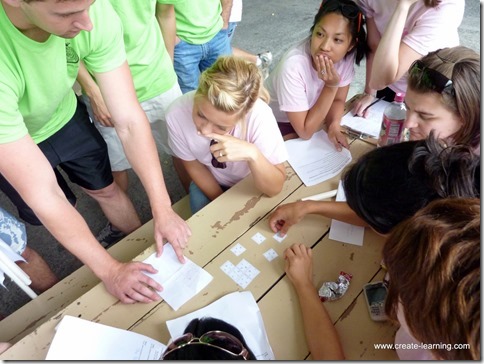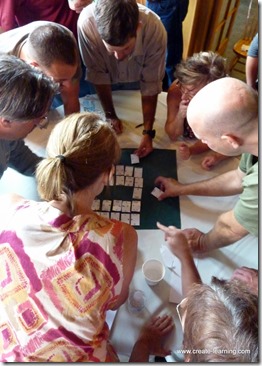
Communicate This and Stick it Here – Corporate team Building Activity
What are the Benefits & Uses?
- A complex simulation that highlights the importance of listening and sense-making of the current environment
- Creates an environment to transfer, strengthen and re-work systems of communication with intra as well as interdepartmental systems.
- Highlight different idioms and references. Phrases and acronyms that may be confusing to other departments and cultures (for global organizations and teams).
Materials:
- Laminated Puzzle (supplied below)
- Blank Puzzle Board
- 30 envelopes – 1 for each puzzle piece
- Countdown Timer
- Stop Watch
Group Size:
- 30 people is ideal
- For smaller groups, you can supply people with more than one puzzle piece or create a puzzle and puzzle grid with fewer pieces
- For larger groups, you can ask people to break into teams i.e. twos or threes, or create a puzzle and puzzle grid with more pieces
Objective:
The aim is for the group to assemble themselves according to the directives and place the Communicate This puzzle pieces into their proper order.
The secondary objective is for the group to explore a complex process that requires mapping, planning, strategy, and situational leadership of each team member.
Concluding in the group exploring and developing improved use of communication systems, process mapping, and listening plus speaking for understanding.
Preparation:
Before beginning this activity with 30 people (see group size above for different group sizes) laminate and cut out each of the square Communicate This puzzle pieces. Place each piece into an envelope.
The Communicate This grid should be on a table somewhere on the opposite side of the room of where you will have the group gather.
Split about ¼ of the room and place on a table the Communicate This blank grid. In the other ¾ of the room will be the working area for the team. It helps to lay a rope or use masking tape to mark the “Grid Area” and “Planning Area”

Have the guidelines written on flip chart paper
Instructions and Facilitator Script:
Hand out the puzzle pieces in a random order to the people; ask them NOT to open the envelopes until the activity begins.
Below is how I explain the initiative
“Each of you has within your envelope specific pieces of information that are needed for your personal advancement and the team’s overall success. Please keep the envelopes sealed until the countdown timer begins.
The objective of this simulation is to place each of the puzzle pieces in the correct order in less than 60 minutes, and then place the puzzle pieces into the Communicate This grid in under 30 seconds.
Here are the guidelines;
- One person per puzzle piece.
- Only you can see, touch, and move your puzzle piece once the envelope in opened.
- NO ONE besides the person assigned the puzzle piece can see, touch and move that puzzle piece at any time in the “Planning Area” and the “Grid Area.”
- Pieces may NOT be exchanged –You must keep your piece at all times.
- Pieces will be assembled correctly (letters, symbols, numbers are the right way up)
- Symbols match so that any two adjacent piece edges match the same symbol
- The color symbols mark the edges of the puzzle (sometimes I leave this guideline out)
- All planning and systemizing will be completed in the Planning Area
- The group will have 60 minutes to plan, prepare, and develop a process for placing the Communicate This puzzle into the grid
- Once 1 person steps into the “Grid Area” the 30 seconds for placing all the pieces correctly in the grid starts.
- For any violation of the guidelines the ethics board requires a penalty of 2 minutes removed from the planning time. You can choose to be a strict or forgiving of the rules as you choose. Observe how the teams and people decide to interpret the rules and use these observations for the processing and reflection.
Any questions? Your time starts NOW.”
Connections and Concepts:
Communicate This is a challenging activity. Expect yelling, confusion, and some chaos in the beginning.
For the team to complete the task a shared use of language for the symbols will be either formally or informally created. Some of the names of the symbols are not commonly known for example, ampersand. Additionally, global team members may not know and have the same symbol and description; this creates a great discussion for the processing, this will create confusion and frustration for people who are working to solve the puzzle.
Pay attention to the group dynamics; are they all working together? Are they splitting into smaller teams? Are the smaller teams sharing information with the larger group? Who is keeping track of the time?
Once the team is all in place, and they are ready to transfer the pieces to the grid, did they remember that once the 1st person crosses the line the 30 seconds for completion starts? Teams need also to plan for how they are going to move everybody in a sequence from the Planning Zone to the Grid Zone and place each piece correctly in the Puzzle Grid.
This is a multi-process, situational leadership simulation.
Processing & Reflection:
Here are some ideas;
Show or list 10 Team Dynamics Great Teams Share;
- Identify a Leader
- Establish roles & responsibilities + discuss what each person ‘brings to the table.’
- Establish a set of goals & objectives
- Establish an agenda for managing time to complete the task/meeting
- Establish a method to determine how they will reach agreement
- Establish ground rules for their meetings
- Proper & timely use of quality tools
- Maladaptive behaviors are properly dealt with immediately and have consequences
- Ability to get started on task/project quickly
- Ability to state what is working and how to improve
Ask the people to break into groups of 4 to discuss and find areas in the initiative that match the Great Team Dynamics.
Following about 10-15 minutes of small group discussion ask the groups to share what they discussed.
Ask the group to split into groups of 6 and to come up with an example from their work lives that is similar to Communicate This.
Allow each group to share the example, and then ask each group to create a solution based idea that can change and improve the example either team explained.
Following the discussion develop a Who :: What :: When
Possible questions for the group
- What was your initial reaction to the challenge?
- On a scale of 0-10; 10 being excellent where would you place the teams planning?
- For the planning to be 1 to 2 numbers higher what would be different? How would you know? What would you notice in other people? What would they notice in you?
- Did any leaders emerge?
- How where disagreement dealt with?
- In what ways is this like work, home, community, etc…?
- How?
- What can we learn from this?
- How can these ideas be brought to the office, home, community, classroom?
Hire Mike
Need experiential and hands-on ways to create lasting memories and content in your programs / workshops / and lessons.
Mike is your answer. He will create and develop customized activities and simulations for what you need. Contact Mike (mike@mikecardus.com)
Mike will come to you to facilitate the action learning and processing, or can just send you a document with videos and photos of how to do everything you need.
Mike will make you a success and your next meeting and training program better than ever.

Michael Cardus is the founder of Create-Learning an experiential based consulting, facilitation, training and coaching organization. Leading to successful results in retention of staff talent, increased satisfaction with work, increased collaboration and information sharing within and between departments, increased accountability of success and failures, increased knowledge transfer, increased trust as well as speed of project completion and decision making of Leaders, Teams and Organizations.

